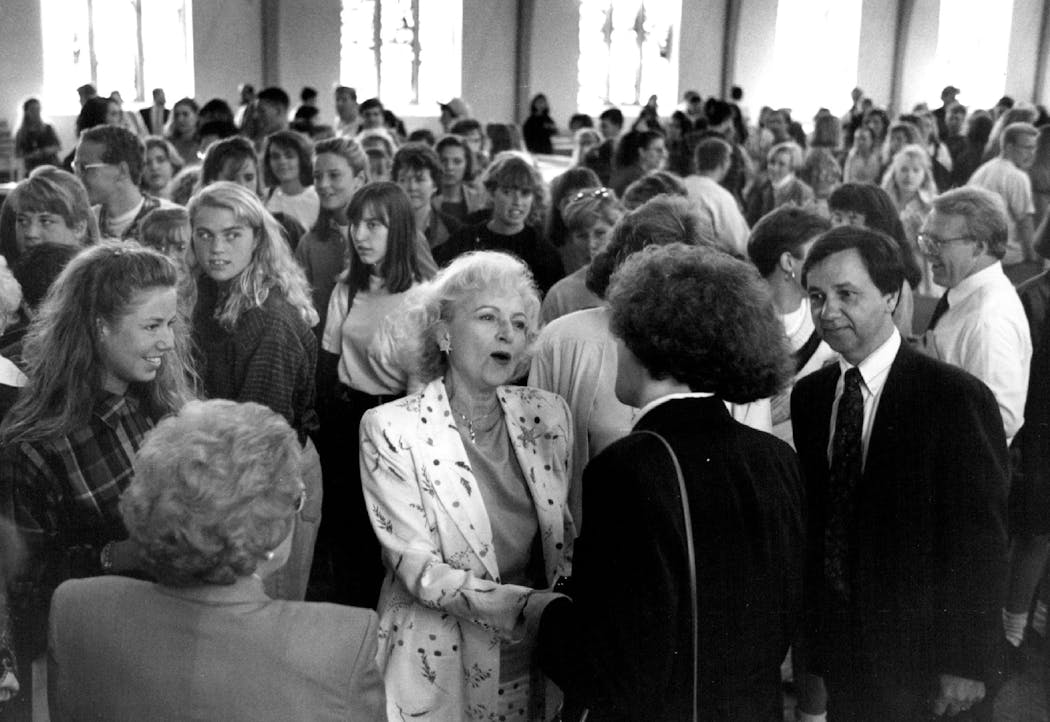How did Minnesota become a recurring 'Golden Girls' joke?
Listen and subscribe to our podcast: Via Apple Podcasts | Spotify | Stitcher
When Ernesto Londoño told friends he would be relocating to Minnesota from Brazil, many in his (decidedly queer) circle wanted to know: Was he going to St. Olaf?
Not the college in Northfield, to be clear. Londoño's friends were referring to a fictional St. Olaf, the rural hometown of Rose Nylund, Betty White's daffy character on the '80s-'90s sitcom "The Golden Girls."
The Emmy-winning series was groundbreaking in its time for dedicating a half-hour each week to the plight of older women. The tales of four cheesecake-loving widows and divorcees living together in Miami turned out to be rife with comedic potential. Dorothy (Bea Arthur) was whip-smart, Sophia (Estelle Getty) was wisecracking and Blanche (Rue McClanahan) was seductive.
And then there was Rose. This gullibly wholesome farmer's daughter hailed from colorful and tight-knit St. Olaf, Minn., a place where chickens play piano, cows have the right to vote, the local newspaper investigates oat fungus and the junior prom is only for people named Junior.
Often the foil for sarcasm and insults from her roommates, Rose shone brightest when sharing nonsensical stories about her fellow St. Olafians, with their Scandinavian-sounding names and unusual traditions.
"Like we say in St. Olaf — Christmas without fruitcake is like St. Sigmund's Day without the headless boy."
(Some traditions were not so far-fetched, by Minnesota standards. For example, Rose once competed for the title of Butter Queen — but lost because of "churn tampering.")
With "Golden Girls" in continuous syndication and streaming online, White's portrayal of a proud Minnesotan has lived on among a new generation of viewers. White died in 2021.
"I found it really interesting that the Rose Nylund character from a show that was on television decades ago still shapes people's perceptions of Minnesota and Minnesotans to this day," Londoño said. "Maybe largely queer people, but it still feels really fascinating to me that she remains an enduring ambassador for the state."
Londoño, a New York Times reporter who is renting office space at the Star Tribune's headquarters, wanted to know more about Rose's version of Minnesota. So, he wrote to Curious Minnesota, the Star Tribune's reader-driven reporting project.
"Was there ever a town or settlement by that name in the state? How did Rose's hometown become such a dominant theme of the show? And were there any strands of truth in the portrait it painted of rural Minnesota and its Scandinavian settlers?" Londoño wrote.
The real St. Olaf
While there's no St. Olaf that resembles anything like Rose's wacky hometown, there are at least two places in Minnesota that share their name with the Norwegian king — and neither have a Department of Water and Coffee or a Day of the Wheat when everyone dresses as sandwiches.
The first is St. Olaf Township in Otter Tail County, about 18 miles southeast of Fergus Falls. The settlement sprung up like many others in Minnesota as immigrants took advantage of the 1862 Homestead Act, said Otter Tail County Historical Society Director Chris Schuelke.
"There is no village or city within its borders," Schuelke said of the township. "What it does have is great soil and lakes."
The other more famous St. Olaf is, of course, St. Olaf College in Northfield. It is so intertwined with its "Golden Girls" namesake that the admissions office mentions the fictional St. Olaf in recruitment letters.
"I think there's a longstanding belief that there is some kind of connection, and it's one of the ways that people know our name," said Chris George, who is the college's associate vice president for enrollment management and dean of admissions and financial aid. "People look [the fictional town] up and find the college, and then they're applying."
George was a student at St. Olaf College in 1992 when White made a legendary visit to campus. She attended a women's softball game and had a guest spot singing "Um! Yah! Yah!" with the St. Olaf Choir. "I definitely remember the fanfare," he said.
Rose's origin story
How did it come to be that White's character hailed from Minnesota in the first place?
The writers developing the dynamic foursome landed on the Upper Midwest "by process of elimination, really," said Jim Colucci, author of "Golden Girls Forever: An Unauthorized Look Behind the Lanai," who conducted dozens of interviews with writers, producers and actors from the show.
With a Southerner (Blanche) and two New Yorkers (Dorothy and Sophia) living together in Miami, that left the middle of the country wide open for lampooning, Colucci said.
As Colucci tells it, "Golden Girls" creator Susan Harris had met a Minnesotan with Swedish lineage while on vacation, "and then it just kind of came together."
Rose was famously Norwegian-American, which she celebrated in stories like the one about Norway's "Great Herring War" (fought over a disagreement about whether herring should be pickled or trained for the circus). These comical tales were punctuated by an over-the-top Scandinavian-esque language that entered words like vertubenflugen into a very particular lexicon.
In that sense, Rose's St. Olaf does share similarities with real-life Norwegian settlements in Minnesota.
"Norwegian immigrants definitely displayed a high degree of ethnic cohesiveness," Schuelke said. "In other words, they tended to stick together." And the earliest immigrants continued to speak Norwegian even while their children spoke English, passing on the tradition through Norwegian-language newspapers.
But there also were distinct differences between sitcom Minnesota and the real Minnesota. For one thing, Rose and her fellow townsfolk are portrayed as exceptionally naïve — if we're being polite.
"We not only took care of our old people, we revered them, honored them, put them on a pedestal. 'Course, that's how we got to be the broken hip capital of the Midwest."
"I have not found Minnesotans to be dimwitted at all," Londoño said. He added that Rose's bubbly, extroverted personality also doesn't seem to exactly match the Minnesota culture.
"I find [Minnesotans] to be friendly, but quite reserved," Londoño said.
Minnesota's national identity
Londoño, who is from Colombia, wondered whether Minnesotans feel about Rose the way he does about the Colombian drug lord Pablo Escobar, who influenced the way Colombians are seen and understood in popular culture.
"This is obviously apples and oranges, but I guess I was really interested in how one character can powerfully shape people's perceptions of a place," Londoño said.
When "Golden Girls" fan Elliott Powell moved here from New York, the University of Minnesota American Studies professor had to reckon with the white, hetero-centric Minnesota stereotypes Rose had contributed to. For him, the questions from friends and family were "whether there were any Black people besides Prince" and whether it was a safe place for LGBTQ people.
"And while I don't think 'The Golden Girls' is a central reason for that, Rose doesn't help in these situations," said Powell, who is Black and identifies as queer. In several episodes, Rose admits that she doesn't understand much about race or sexuality.
But Rose wasn't the only symbol of Minnesota in the 1980s, which might explain why Minnesotans hardly felt a need to launch a large-scale revolt against her portrayal.
"'The Golden Girls,' historically, comes at an interesting time where Minnesota actually has a particular prominence in terms of pop culture, but also politics," Powell said.
Walter Mondale lost the presidential election and Prince's "Purple Rain" came out a year before the show debuted. And it's worth noting that White played a much saucier Minnesotan a few years earlier on the "Mary Tyler Moore Show." Anyone who was tapped into popular culture at the time would have gotten a broader view of Minnesota than simple St. Olaf.
For all the exaggerations in White's take on a Minnesotan, there also was a lot of heart.
"Maybe we don't have French boutiques and valet parking and facelifts for Christmas vacation, but we have friends and family and a sense of community and caring, and that's pretty special."
Powell said one of the things he learned after moving to Minnesota is that – like Rose – "people have a lot of pride in being from Minnesota, about loving Minnesota."
More Rose-isms:
"You know what they say: You can lead a herring to water, but you have to walk really fast or he'll die."
"If you hold a bird gently, the bird will stay. But if you squeeze the bird, his eyes will bug out."
"I'm probably the most patient person you know. Go ahead, try to think of somebody else. I'll wait."
Dorothy: "Et tu, Judas?" Rose: "No, it's me Rose! I'm just wearing my hair a little differently."
"The older you get, the better you get. Unless you're a banana."
If you'd like to submit a Curious Minnesota question, fill out the form below:
Read more Curious Minnesota stories:
Where does 'uff da' come from, and why do Minnesotans say it?
Why did Scandinavian immigrants choose Minnesota?
How we choose Curious Minnesota questions submitted by readers
What was the first movie filmed in Minnesota?
Is Minnesota actually more German than Scandinavian?
How did these 11 Minnesota towns get their unusual names?








